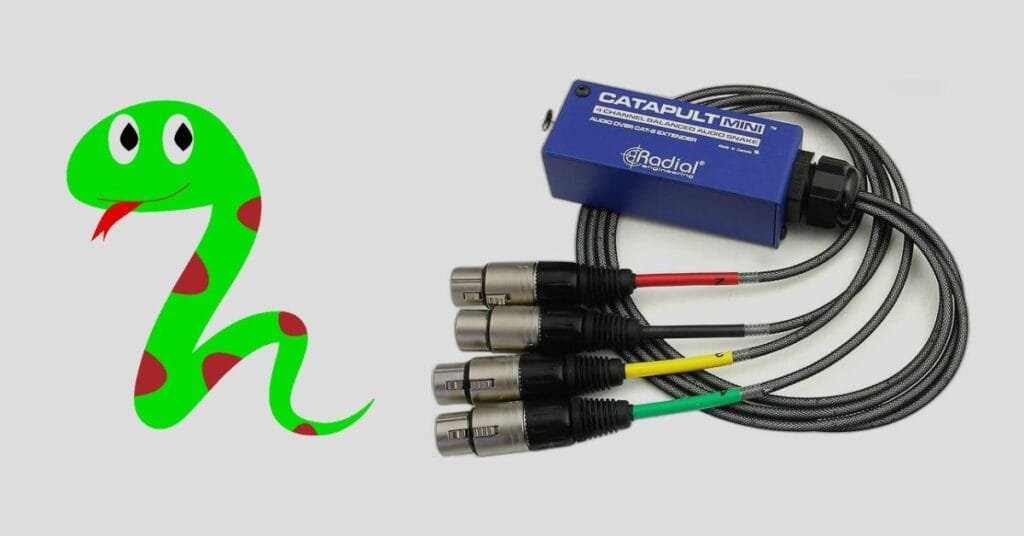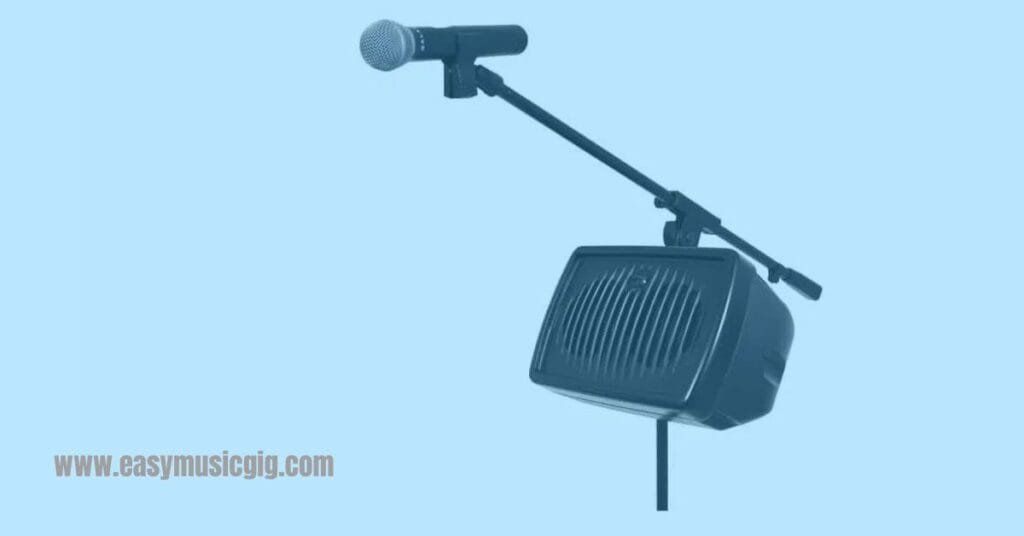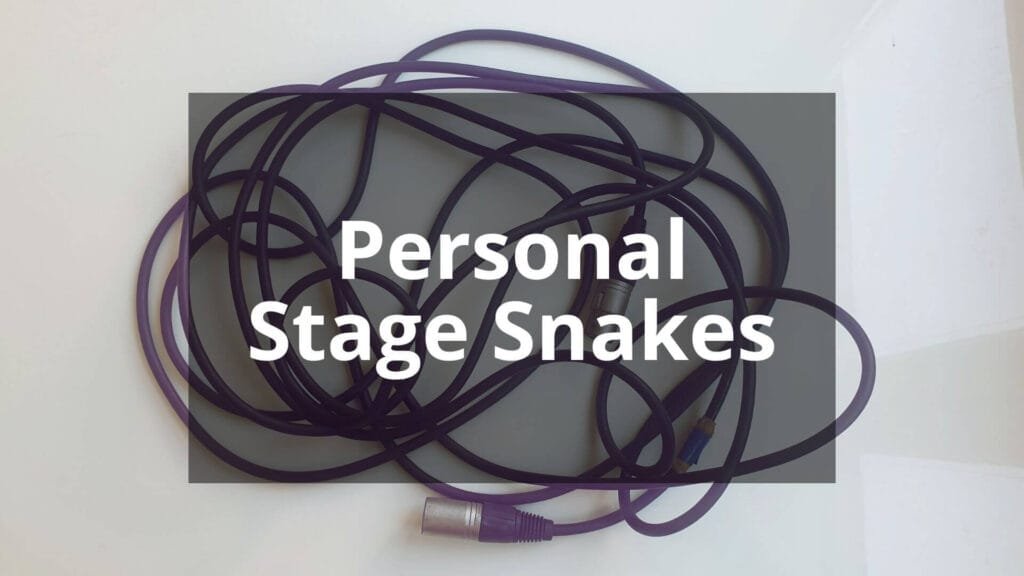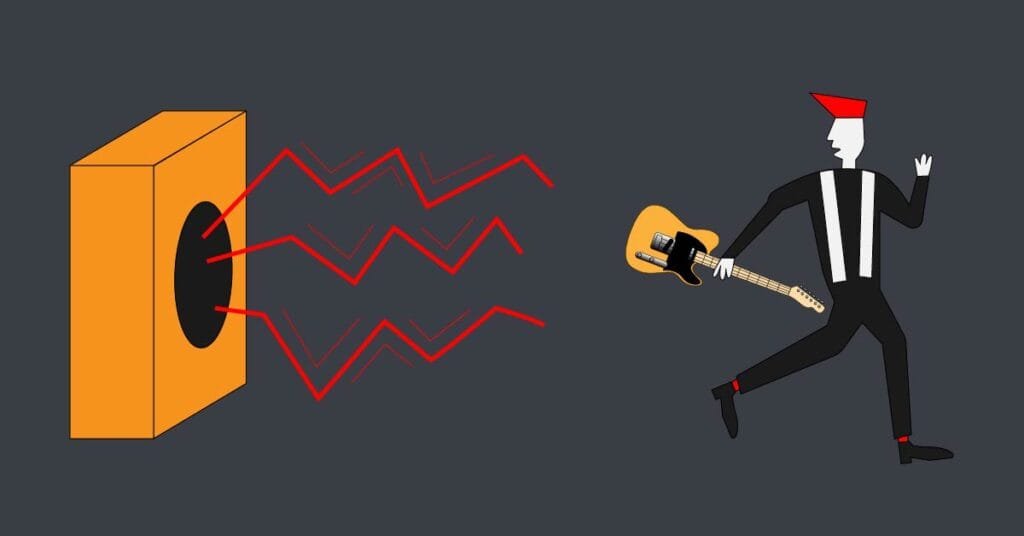Audio Snakes with Cat (Ethernet) cables: The Cat snake
Introduction
Easymusicgig.com is all about making things easier for us who gig frequently. Today we will talk about a simple and modular solution that uses cables known for digital usage in an audio environment and products needed for this system. This article is about the use of Cat cables for transferring analog signals in audio snakes. At first, this sounds odd, so let’s start explaining. Before we start talking about audio snakes with CAT (or Ethernet) cables we should first explain some basic principles for those who are new to audio snakes.
An audio snake (also called multicore) cable is a cable that is used for sending and receiving all audio inputs between the stage and the main mixer which is located in a relatively distant location. The location is usually where the audience is, not too far from the stage, positioned in the middle, or left or right close to the stage or on it. Without the use of an audio snake, we would need to use dozens of 50-100m long cables which would be unpractical in every aspect.
All audio signals meant to be heard through the main PA (FOH) are sent to the mixer and all monitor, main PA, and internal monitoring (sound engineer’s voice on stage) audio is sent from the mixer to the stage via audio snake.
The audio signal that travels through the snake can be analog or digital, depending on your preferences and needs.
Analog audio snakes can be very bulky and heavy due to channel count and length compared to digital snakes which can handle all channels with only one Cat cable.
Wait a minute, how can Cat cables be used for analog signals then? Can an ethernet cable be used for audio? Yes! Cat or ethernet cables include four twisted pairs of cables that are excellent for sending four audio signals. There are several types of Cat cables ranging from Cat5 to Cat8, with higher numbers offering higher shielding and quality.
Analog snake with cat cable: Elements
To build a small analog snake using Cat cable we need these three elements:
- Stagebox transmitter
- Cat cable
- Stagebox receiver
This system works in the same way a traditional analog snake does. The main difference is the cable that connects the stage boxes. Instead of a cable that has 4 XLR-balanced cables inside of it, we are using one Cat cable. As you see, with the use of a Cat cable we are limited to only 4 signals. Some manufacturers are making one-unit (1U) sized rack units with three 4-signal stageboxes for easy setup when 12 channels are needed.
The stageboxes needed for this setup are modified compared to traditional stageboxes. Here we don’t have a fixed multichannel bulky XLR cable coming out of the stagebox. Instead, we have RJ45 inputs for shielded Cat cables which gives us the flexibility to choose whatever cable length we need for a specific scenario.
The receiver stagebox always has a fan-tailed design for connecting to the mixer. Transmitter stageboxes can be made with or without fan tails.
How do Cat/Ethernet audio snakes work?
The main factor about Cat-based audio snakes is that they are not digital audio systems. They use Cat cables that are mostly used in digital systems but because of their ability to carry four balanced analog audio signals and very small footprint, they are excellent for small to medium concert setups and studios.
The stageboxs used in these systems do not convert signals from analog to digital or vice-versa, they simply convert XLR inputs to Cat cable-type inputs in the transmitter and the other way around in the receiver.
Pros of using Cat cables for analog audio snakes
Before we see some products that suit all budget types and see how they work, let’s mention the main advantages of using an analog audio snake with Cat over traditional multicore cables.
1. Lightweight and small
CAt cables are incomparably thinner and lighter than XLR cables, so everything from transport, and setup to teardown will be easier.
2. Flexibility and distance
Audio transmitted with Cat cables has minimal degradation and can be sent to distances over 100m. Since these cables take up very little space we can have two or three of them in different lengths to meet our needs at specific venues.
Many buildings have an existing cable infrastructure that we can take advantage of. Simply integrate one transmitter stagebox on one floor and the other receiving stagebox on another floor.
3. Low cost
CAT cables are much cheaper than four XLR cables in a multicore cable. The more channels you use the more you will save with this system.
4. Shielded CAT cables
One huge advantage of Cat cables for audio systems is that they come in various shielded options which include braided wire and foil wrap. All this shielding is connected to special protective jacks that are in fact an RJ45 with XLR housing jack. Shielding ensures that the audio signal stays clear for long distances without any unwanted noise. If you want to be able to run phantom power through your snake a shielded Cat snake is necessary.
5. Easy setup
Setup and teardown for gigs are much faster and easier when using audio snakes with Cat cables instead of classic XLR multicore cables. There is less clutter on stage, the gear is smaller, lighter, and easier to work with.
Because of their very small physical size, Cat or Ethernet cables are very easy to route in small spaces.
6. High quality
CAT cables that are used in these systems are designed for stage use unlike classic CAT cables used for home or office use.
7. No Digital audio conversion
Although an ethernet Cat cable is used there is no need for analog-to-digital and digital-to-analog conversion as when transferring digital signals in a digital sound snake.
Best analog audio snakes with CAT/Ethernet cables
1. Radial Catapult MINI TX Cat 5 Audio Snake
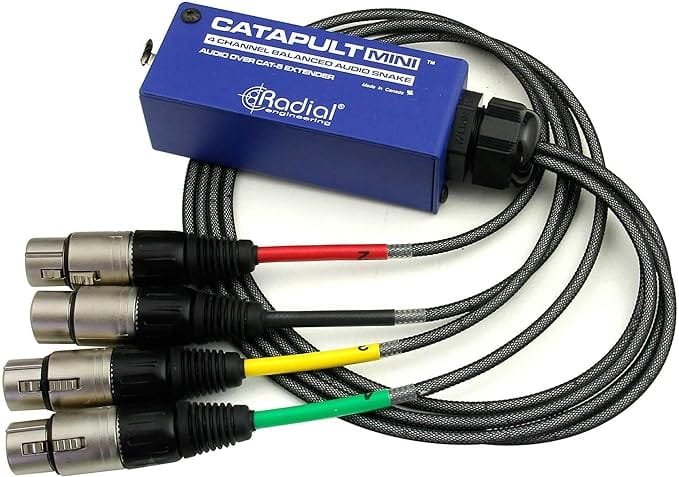
Main Features:
The Radial Catapult MINI TX Cat 5 Audio Snake transmits 4 channels of analog audio via Cat5 or Cat6 cable. It is designed to work with the Radial Catapult MINI RX which serves as a receiver. These two devices, when connected with a shielded Cat5 or Cat6 cable work as a 4-channel analog snake that can deliver balanced audio signals to wherever you need them. The Catapult is a passive device and also comes in a TRS version.
All Radial Catapult products are compatible with each other making them the industries standard for top-quality modular solutions for analog audio through Cat cables.
2. Radial Catapult TX4 4-channel Cat 5 Audio Snake Module
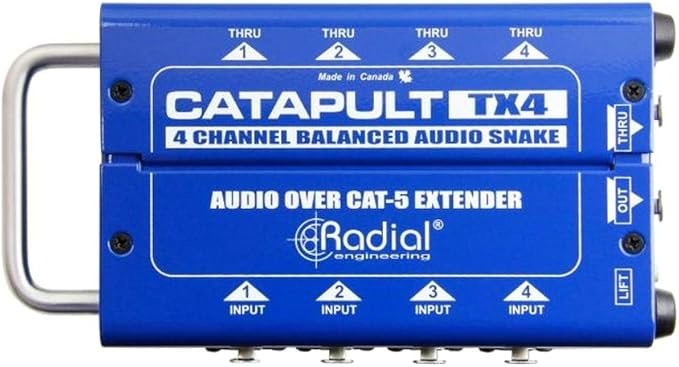
Main Features:
Compared to the Catapult Mini, this Radial Catapult analog stagebox has thru outputs for all 4 channels and a RJ45 thru for parallel connection to feed additional Catapult models. It works with the Radial Catapult RX4 receiver as a top-quality 4-channel analog snake with thru option.
3. Radial Catapult Rack TX 12-channel Cat 5/6 Analog Audio Snake

Main Features:
The Radial Catapult Rack TX is actually three 4-channel Catapults in a 1-unit rackmount format for ease of use when more channels are needed. It comes with a ground lift for each of the three sections to remove hum and buzz caused by ground loops. It works as a 12 channel analog snake when paired with the Radial Catapult RX Rack receiver model with three Cat cables.
4. LyxPro Pair of LyxPro Audio Snake 4 Channel XLR 3 Pin Multi Network Breakout
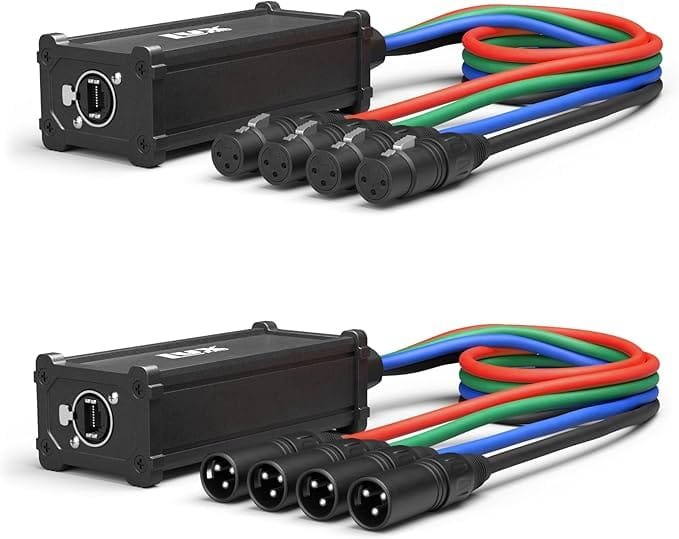
Main Features:
5. CAT Box MFX – 2 Male 2 Female XLR Stage Box with Analog Audio Over Shielded CAT Cable
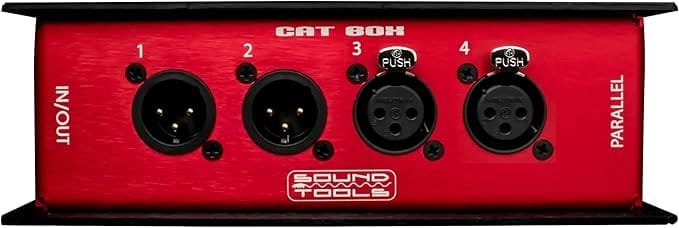
Main Features:
The Sound Tools CAT Box MFX is a stage box that can send and receive two analog audio signals making it a transmitter and receiver. It is an ideal solution for a modular snake for gigging musicians. Simply connect two Cat Box MFX stage boxes with a Cat5, 6, or 7 cable and you have a fully functional analog snake that can send two signals (i.e. Vocals and guitar) and receive two signals (i.e. monitor signal in front of the player) all with a single Cat cable.
6. Whirlwind Catdusa CT-F RJ45 Breakout Adapter with 4x 1.5′ XLRF Cable
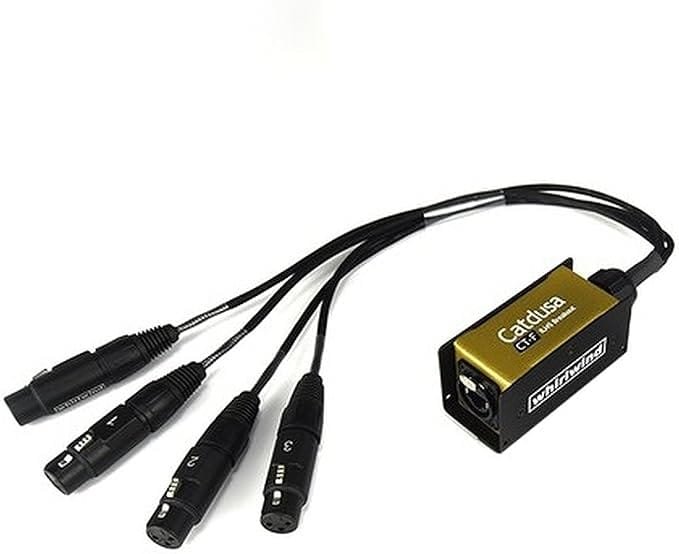
Main Features:
Examples of use
Multiple 4-channel small stageboxes can be used for a larger channel system, but using them as a sub-snake is what makes them shine.
1. Drum sets
One or two sets of small 4-channel analog audio snakes with Cat cables are enough to mic any drum set in no time.
2. Backing vocals
A great use for these small analog snakes is for backing vocals. Many concert setups have the backing vocalists placed in one spot on the stage.
3. Stage monitoring
Stage monitoring requires changing the order of male and female stage boxes due to the opposite signal flow of signals that go to FOH. In some cases, you can use this system only for the stage monitors.
4. Multi-instrumentalists
Musicians who play multiple instruments can benefit from using Cat cables for their personal stage snake.
Who can benefit:
- Guitarists with multiple instruments (guitars, mandolin, ukulele)
- Instrumentalists who also sing
5. DMX
The type of stage (or breakout) boxes that we are talking about in this article can also be used for DMX signals besides analog audio. The shielding in CAT cables that are used here is what makes this use possible
Conclusion
Analog audio over Cat or ethernet cables is becoming the new way for many sound engineers and musicians who need small, lightweight, and modular ways to setup their stage and studio systems. Cat cable systems provide a flexible and affordable alternative to XLR audio snakes. Even if you are not using this type of audio snake on a regular basis, they are a valuable piece of backup gear to have in your accessories case if needed.
An analog audio system with Cat cables can reduce your setup and teardown time and reduce cable clutter on stage or in the studio, making it a versatile and modular solution for smaller setups. The good thing about this system is that you don’t have to purchase a big 16 or 24-channel stagebox system because you think you may need it in the future channel-wise.
